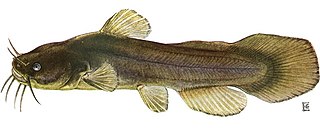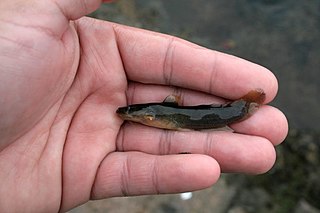
The Ictaluridae, sometimes called ictalurids, are a family of catfish native to North America, where they are an important food source and sometimes fished for sport. The family includes about 51 species, some commonly known as bullheads, madtoms, channel catfish, and blue catfish.

Ameiurus is a genus of catfishes in the family Ictaluridae. It contains the three common types of bullhead catfish found in waters of the United States, the black bullhead, the brown bullhead, and the yellow bullhead, as well as other species, such as the white catfish, which are not typically called "bullheads".
Prietella is a small genus of North American freshwater catfishes found in Mexico and Texas, and restricted to underground waters.

The yellowfin madtom is a species of fish in the family Ictaluridae endemic to the southeastern United States. Historically, the yellowfin madtom was widespread throughout the upper Tennessee River drainage but was thought to be extinct by the time it was formally described.

The orangefin madtom is a species of fish in the family Ictaluridae. It is endemic to the United States, and was originally described from the Roanoke River of Virginia.

The frecklebelly madtom is a species of fish in the family Ictaluridae endemic to the United States. Madtoms are in the genus Noturus, which is a group of catfish prevalent in North America. In 2023, the Upper Coosa River distinct population segment (DPS) of N. munitus was listed as federally threatened under the Endangered Species Act of 1973.
The pygmy madtom is a species of fish in the family Ictaluridae endemic to the United States, in only two known regions of Tennessee. Madtoms are the smallest members of the catfish family. Members of the genus Noturus can be distinguished by their small size, unusually long adipose fin, and rounded caudal fin. Most specimens have been collected over shallow, fine gravel shoals with moderate to swift flow, usually near the stream bank.
The Caddo madtom is a species of fish in the family Ictaluridae endemic to the United States. N. taylori was named in honor of William Ralph Taylor, U.S. National Museum, in recognition of his contributions to the knowledge of catfishes. They average 2 to 4 inches long and weigh no more than a few ounces. N. taylori has a small to tiny, fragmented range, but is mostly found in the Caddo, Ouachita, and Little Missouri Rivers in southwestern Arkansas. Ecological studies indicate that dam and bridge construction poses barriers to dispersal and migration of fish in the Ouachita Highlands. IUCNredlist.org states that better information is needed on life history, reproductive biology, and ecology of the Caddo madtom. This species is listed as endangered on the IUCN Red List. Limited range makes this species vulnerable to habitat destruction/degradation from impoundment, pollution, and other factors. Robison and Buchanan (1988) stated, "this rare species should be considered threatened due to loss of habitat". Warren et al. (2000) categorized the species as "threatened".
The Scioto madtom was a species of fish in the family Ictaluridae. It is listed as extinct by the International Union for Conservation of Nature, which notes that it has likely been entirely or functionally extinct since 1957 given the lack of records since that year.

The tadpole madtom is a species of fish in the family Ictaluridae. It is native to Canada and the United States.

The chucky madtom is a critically endangered freshwater fish endemic to the U.S. state of Tennessee.
The elegant madtom is a fish native to Tennessee, Alabama, and Kentucky, and is one of twenty-nine species of madtom. It prefers to live in small rivers and gravel-bottomed creeks. The average lifespan of the elegant madtom is two years.
The mountain madtom is a North American species of temperate freshwater fish belonging to the Noturus genus of the family Ictaluridae. The species was first described to the United States National Museum by Professors Jordan and Gilbert in the Big Pigeon River. The mountain madtom has a body that is characterized as being robust, and by the toxic sting that is associated with their pectoral and dorsal spines. Currently, the Pigeon River Recovery Project is working to try to restore the mountain madtom population that was lost in fisheries. Aside from the Pigeon River Recovery Project, there is little management being applied to this species, and it is currently listed on the threatened species list for the state of Tennessee.

Noturus exilis, also called the slender madtom, is a species of the catfish family Ictaluridae. Ictaluridae includes bullheads, madtoms, channel catfish, and blue catfish. Noturus exilis is found in the central portion of the Mississippi River basin, but is most abundant in Ozarkian streams. Slender madtoms occur west of the Mississippi River in the Ozarks of Oklahoma, Arkansas, and Missouri north to southern Wisconsin and Minnesota. It also occurs east of the Mississippi River in the uplands of Alabama, Tennessee, and Kentucky in the Tennessee, Cumberland, and Green drainages. Nelson first described Noturus exilis in 1876. The slender madtom is moderately large with a terminal to sub terminal mouth, flat head, small eyes, and black marginal bands on the median fins. Most slender madtoms are less than 90 millimetres (3.5 in). Noturus flavus and Noturus nocturnus are rather similar in shape and coloration to Norturus exilis. Slender madtoms inhabit small to medium-sized streams, in riffle and flowing pool habitats with coarse gravel to slab rock substrates. The presence of a shelter object, such as a large rock, seems to be important in habitat selection.

Noturus fasciatus is a rare freshwater fish native to the U.S. state of Tennessee. It was first described as a species separate from Noturus crypticus in 2005. It is restricted to the Duck River system and is also found in two minor tributaries on the lower section of the Tennessee River. This species dwells in small to medium-sized streams where they can be found under gravel, rubble, and slab rock. They feed mostly on insects such as: stone, cattus and mayfly larvae.
The piebald madtom is a species of madtom catfish that is found in seven river systems in the Tennessee and Mississippi coastal tributaries. The most common systems N. gladiator is found in are, the Hatchie River, Obion River, and Wolf River. This species is very susceptible to environmental changes including flow regimes, siltation in nesting sites, and poor environmental quality. The Noturus catfish reproduces from February to September and females reach sexual maturity in only one year. Current management strategies for this recently discovered species haven't been completely developed yet, but could be comparative to the management of other madtom species. Siltation in the southern portions of the rivers, inhabited by Noturus gladiator that comes from the northern aspects of the waterways is causing stress on the reproductive success due to nest suffocation. There are records as close as twenty years ago showing the species inhabiting multiple other rivers around the areas it currently inhabits. This could be a sign that the species is in a decline. There should be population surveys done on the existing habitat and water quality surveys done in the inhabited areas as well as the uninhabited neighboring areas to see what the limiting pollutant might be in the water causing habitats to shrink. The area that this species inhabits needs to be managed in a way that could see a resurgence in gladiators numbers.

The brindled madtom is a small catfish of the family Ictaluridae that is native to the eastern United States.

The freckled madtom a species of freshwater madtom (catfish) found in the eastern United States. The freckled madtom is a benthic feeder mostly of invertebrates and usually inhabits waters that are medium to large in size, living mostly in riffle areas that have mostly clear waters and rocky bottoms. Its spawning season occurs from spring to early summer in riffle areas, and sexual maturation occurs after two years.
The black madtom is a nocturnal, freshwater, diminutive catfish found in watersheds in Florida, Louisiana, Alabama, and Mississippi, and is one of 29 species of madtom.
The Checkered Madtom is, a small freshwater catfish found in the United States, in the rivers of Arkansas and Missouri. It is one of 29 species of madtom.











